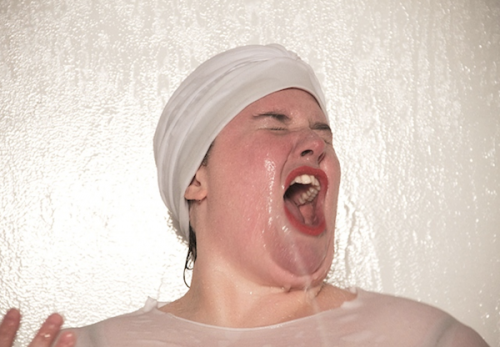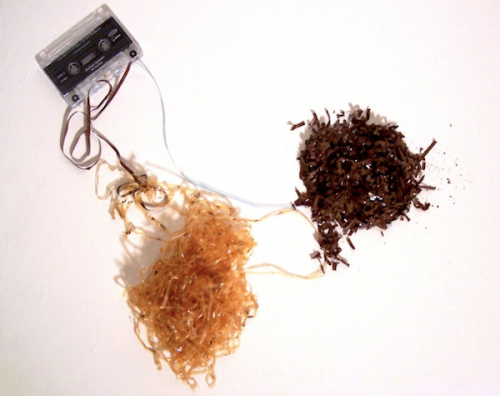In any place that isn’t the otherworldly realm of the ACRE Residency, twelve days doesn’t feel like a long time away from one’s day-to-day life. Launched in 2010 by Nicholas Wylie and Emily Green, ACRE (short for Artists’ Cooperative Residency and Exhibitions) was founded with the mission of providing the arts community with an affordable, cooperative and dialogue-oriented residency. Set on 1,000 acres of Wisconsin farmland, in an area so remote that one can’t get cell phone reception and even the Internet flickers at times, ACRE staff runs three 12-day residencies every summer, hosting 25–30 residents at a time. This year I am a curator with ACRE–it was one of the main inspirations for this Art21 series that is now coming to an end.
In this final post, I talk with two-time ACRE resident Meg Leary, who attended in the summers of 2011 and 2012. Her multi-disciplinary practice incorporates sound, performance, and visual art for multisensory experiences that bring together her formal operatic and stage training. In her work, she explores the corporeal body of the diva and performer, questioning the relation of voice to the performative experience. And yes, Leary is interested in “diva” in that sense of the word. By applying strategies from music theory (such as repetition, harmony, and remixing) to her stage presence and performances, she forms an aesthetic that is entirely her own. From her two summers at ACRE (not to mention winning the Critical Fierceness Grant), Leary has been able to bend and shape her practice, forming it anew.
Alicia Eler: Tell me a bit about your practice. What are you working on now?
Meg Leary: My practice is fairly diverse…Right now, I am working on a performance that will take place in an underpass in Chicago. Since going to ACRE I have wanted to work in urban spaces that have amazing acoustical properties and reverberation potential. I am really spoiled at ACRE, where I’ve been singing in an empty grain silo, because everything sounds amazing in there. That is a really pleasurable experience for me—being surrounded by sound in a way that is almost physical. I’m looking forward to doing more site-specific performances.
AE: What made you decide to apply for the residency not once but twice?
ML: Another artist, Jenny Kendler, went to the ACRE residency in 2010, and when she returned she recommended that I check it out. ACRE has a sound program that includes a full music/sound studio and they have a lot of bands that participate in their programming. It was the first time I had gone to a residency, and having a sound program was really exciting for me. I assumed I would work in the studio but when I got there I ended up doing audio recordings in the empty grain silo.
I think what was intriguing for me about ACRE, and why I went back a second time, is the ethos of art as a practice—something that is active and is learned and discussed. They have daily workshops to teach new skills or to learn about issues in Wisconsin. You can learn about cheese making one day and taking a printmaking class the next. I even taught a class on grants for artists. This attracts people who have varied interests and backgrounds—writers, artists, musicians, chefs. The structure and physical layout of the residency makes it easy to work in relative solitude or to collaborate depending on your needs and practice.
AE: How long did it take you to get acclimated to being at ACRE? How long did it take you to adjust when you returned to Chicago? How did ACRE alter perceptions about your practice?
ML: Since I have a full time job in Chicago, the ability to set aside that area of my life and concentrate fully on art for a week or two was a really precious gift. It is a difficult transition in and out since it is a different character of thinking and of being. I find it really important to be in another landscape to make that transition. There is very little cell service at ACRE that I think helps me to be receptive to the world around me instead of looking down at a phone all the time. I find myself slowly picking up my eyes and taking in the colors and sounds and people.
One of the great things about ACRE is that it doesn’t end at the residency, and that the community and exhibitions continue throughout the year so that you can continue collaborations, conversations, and friendships. That makes it an easier adjustment.
AE: What were you working on before you went to ACRE? How did the work transform again when you returned to Chicago?
ML: I used to sing in my work, but when I first went to ACRE I had not been singing for a number of years. I decided to just start singing every day on the property. Soon enough I was playing and creating sounds with a violinist, Allison Trumbo, and then another artist, Mikey McParlane. This development has been really pivotal to my practice, and singing is once again playing a large role in my work.
AE: Tell me about performances you’ve done since returning from ACRE! I am thinking about the Miami ACRE performance, the Chances Dances collaboration with Brian Kirkbride and…what else?
ML: I was able to travel to Miami during the December art fairs to do a performance in conjunction with ACRE’s exhibitions there. I did a series of operatic interpretations of contemporary pop songs, including Taylor Swift’s “We Are Never Ever Getting Back Together” and Ke$ha’s “Blow.” It was really fun doing a totally wild and funny piece in an environment that is so hyper-commercialized. Those fairs are so excessive and what’s more over the top than an opera diva?
________________________________________
Meg Leary is based in Chicago. She received an MA degree in Performance Studies from NYU’s Tisch School of the Arts and an MFA in Performance from the School of the Art Institute of Chicago. Her work has been shown in Chicago at The Peanut Gallery, Links Hall, Medicine Park Gallery, and Elegant Mr. Gallery; Grand Rapids, Michigan at Kendall College of Art & Design; and New York City at the Hemispheric Institute of Performance and Politics. She is a founding member of Henbane Collective.
Alicia Eler is Art21’s February blogger-in-residence. An art critic and curator, this spring/summer she will curate three two-person shows at ACRE: Meg Leary and Emily Carter (May 5–20); Kris Harzinski and Will Haughery (May 26–June 10); and Ricardo De Sousa Costa and Abinadi Meza (June 16–July 1); and one group show for Co-Prosperity Sphere (Chicago) featuring the work of Alicia Chester, Kate Hampel, Ellen Nielsen, Oli Rodriguez, and Aiden Simon.






Pingback: Duh, It’s Postmodern Poetry | Radio Free